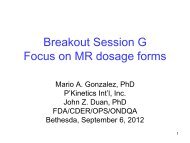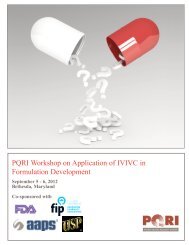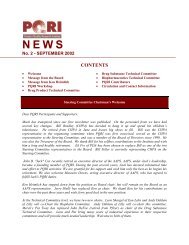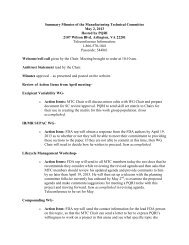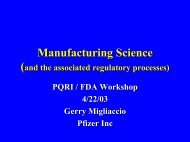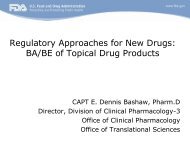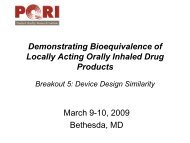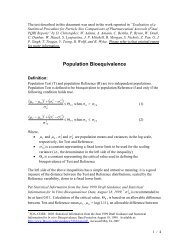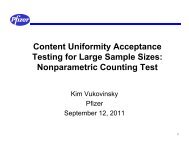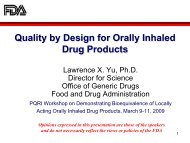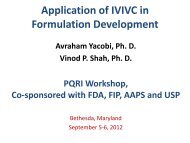Daniel Norwood - PQRI
Daniel Norwood - PQRI
Daniel Norwood - PQRI
Create successful ePaper yourself
Turn your PDF publications into a flip-book with our unique Google optimized e-Paper software.
Presentation Outline• Why produce “Best Practice”recommendations?• The Working Group’s hypothesis• Laboratory work in support of recommendations• Recommendation areas• Introduction to recommendation specifics
Why Produce “Best Practice” Recommendations?• To reduce uncertainty in the pharmaceuticaldevelopment process for OINDP.• To reduce or eliminate “Horror Stories” .• To support Agency initiatives, such as Qualityby Design and Risk Management.
Simulated Project Team MeetingCan’t we alljust get along?
Simulated Encounter with Senior ManagementSimulatedProject TeamLeaderBut it was aProject Teamdecision!!!!SimulatedVPSimulatedNDA
The Working Group’s Hypothesis1. Scientifically justifiable thresholds based on the best available dataand industry practices can be developed for:a. the reporting and safety qualification of leachables in orallyinhaled and nasal drug products, andb. reporting of extractables from the critical components usedin corresponding container/closure systems.Reporting thresholds for leachables and extractables will includeassociated identification and quantitation thresholds.2. Safety qualification of extractables, would be scientifically justifiedon a case-by-case basis.
• Volunteer laboratoriesLaboratory Work• Custom made “Test Articles” (3 elastomers andone plastic, all with known formulations)• Two Phases of extractables work (both protocoldriven):• Phase 1 – Qualitative Controlled ExtractionStudies• Phase 2 – Analytical MethodOptimization/Validation• Placebo leachables studies
Chemistry: Volunteer Laboratories• Boehringer Ingelheim Pharmaceuticals, Inc.• Cardinal Health (Magellan Laboratories)• CIBA Expert Services• Merck and Company, Inc• West Monarch Analytical Laboratories• PPD• Valois, Inc• West Pharmaceutical Services• FDA• Owens Illinois• Chevron Phillips
Rubber Formulation A (Sulfur Cured)Ingredient %CALCINED CLAY 8.96BLANC FIXE (barium sulfate) 25.80CREPE 38.22BROWN SUB MB 16.841722 MB 2.11ZINC OXIDE 4.042, 2’ METHYLENE-BIS (6-TERTIARY BUTYL-4-ETHYL PHENOL) 0.56COUMARONE-INDENE RESIN 1.12PARAFFIN 1.12TETRAMETHYLTHIURAM MONOSULFIDE 0.11ZINC 2-MERCAPTOBENZOTHIAZOLE 0.29SULFUR 0.84
Polypropylene FormulationIngredient wt %• Primary StabilizersTetrakis (methylene(3,5-di-t-butyl-4-hydroxyhydrocinnamate)) methaneIrganox 1010 (Ciba)Anox 20 (Great Lakes)0.08 wt%• Secondary StabilizersBis(2,4-di-t-butylphenyl)pentaerythritol diphosphiteUltranox 626 (GE)0.05 wt%
Polypropylene FormulationIngredient wt %• Corrosion InhibitorsCalcium Stearate 114-50 (Ferro)• AntistaticVegetable oil derived90% alpha monoglycerides (soybean)Pationic 901 (Patco)Dimodan HS-KA (Danisco)• Nucleating Agents3,4 -dimethyl dibenzylidene sorbitolMillad 3988 (Milliken)0.03 - 0.4 wt%0.3 wt%0.2 wt%
State-of –the-Art InstrumentationX
A “Modern” LC/MS System
Chemistry: Phase 1 Studies• Controlled Extraction Studies• Multiple solvents with differing polarities:– Dichloromethane, 2-propanol, hexane• Multiple extraction techniques– Sonication, Soxhlet, reflux• Multiple analytical techniques– GC/MS, LC/UV (DAD), LC/MS
Representative Extraction Apparatus
GC/MS Extractables Profile of the Sulfur-Cured ElastomerAbundance1.35e+07TIC: 02050302.D1.3e+071.25e+071.2e+071.15e+071.1e+071.05e+071e+07950000024 hr Soxhlet extractionIn methylene chloride90000008500000800000075000007000000650000060000005500000500000045000004000000350000030000002500000200000015000001000000500000Time-->05.00 10.00 15.00 20.00 25.00 30.00 35.00
GC/MS Extractables Profile of Valois ElastomerMethylene Chloride Soxhlet ExtractAbundanceTIC: 08190302.D7000000650000060000005500000I.S.BHT500000045000004000000C1822463500000300000025000002000000PeroxideFrags.?C16Irganox 107615000001000000500000Time-->5.00 10.00 15.00 20.00 25.00 30.00 35.00
LC/MS Extractables Profile of Polypropylene MethyleneChloride Reflux ExtractReflux PP Disc/CH2Cl203270311 4280 nm10.55ANALOG1005.22e51220.92%25.340%38.44918.90 33.9203270311 8Scan AP-18.36TIC100111.27e720.2533.17 5.02 8.55410.64716.0295 1013.50 61234.0125.63 31.38 40.3137.86 44.9105.00 10.00 15.00 20.00 25.00 30.00 35.00 40.00Time
Chemistry: Phase 2 Studies• Sulfur-cured elastomer (Ciba)– Completed optimization of extractions using Soxhletextraction with methylene chloride– Completed validation on GC/FID method– Details available in poster presentation• Polypropylene (West Monarch)– Completed optimization of extractions using reflux inisopropanol and THF– Completed validation of LC/UV method– Details available in poster presentation
SULFUR-CURED ELASTOMER EXTRACTABLES<strong>PQRI</strong> Extractives Phase II Exp. 210.90.8Area ratio, analyte to IS0.70.60.50.40.3PhenolicDocosaneHexacosaneCoumarone indene0.20.100 2 4 6 8 10 12 14 16 18Time, hours
Placebo Leachables Study• Samples contained informulation developmentbottles (plastic coated)• CFC-11• Sulfur-cured elastomer
Laboratory Scale StabilityChamber• Note inner door• Note placeboleachables study instorage• 40°C/75%RH• 3 months storageanticipated
Leachables Profile – 1 Week TimepointAbundanceTIC: 11100303.D1.4e+071.3e+071.2e+071.1e+071e+0790000008000000700000060000005000000I.S. 40µg/canister4000000300000020000001000000Time-->05.00 10.00 15.00 20.00 25.00 30.00 35.00
Leachables Profile – 1 Week TimepointExpandedAbundance1200000TIC: 11100303.D11000001000000900000800000700000600000500000400000300000200000100000Time-->5.00 10.00 15.00 20.00 25.00 30.00 35.00
Recommendation Areas• Container/Closure System Components –Composition and Selection• Controlled Extraction Studies• Leachables Studies and RoutineExtractables Testing• The Analytical Evaluation Threshold(AET)
Specific Questions Addressed1. What does it mean to “identify” aleachable or extractable?2. How do you “correlate” extractables andleachables profiles? What does the term“correlate” mean?3. How do you optimize extractablesmethods? What are “asymptotic” levels?
Introduction to Recommendation Specifics1. Component Selection – Fran DeGrazio2. Controlled Extraction Studies – TomFeinberg3. Leachables Studies and RoutineExtractables Testing – Diane Paskiet4. Analytical Evaluation Threshold – Dan<strong>Norwood</strong>
Final Points• The “Best Practice” recommendations aredesigned to be comprehensive.• We welcome your comments andsuggestions.• I did not personally create the issue ofleachables/extractables in OINDP.



